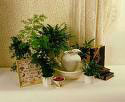
Vol. VI, No. 4, November/December/January/February 2008
- Editor's Note
- Indoor Plants Can Clean Air
- Building a New Center or Remodeling? Interested in Healthier Spaces for Children? Want to Create Naturalized Outdoor Spaces? Want to Know More About Green Design?
- Does Your Outdoor Play Environment Need Some Design Creativity?
- Consumer Product Safety Commission Revises Handbook for Public Playground Safety
- The Trust for Public Land Joins the Children and Nature Movement
- Elmer's Glue Crew Recycling Program
- Is Your Outdoor Surfacing Really Engineered Wood Fiber?
- Post Occupancy Design Evaluation at School for the Disabled
- SafeToys.com Offers New Roundtable on Toy Safety
- The National Children's Study Looks at Long-Term Connection Between Children's Health and the Environment
- Attracting Birds to Your Center
- Recent Projects
Indoor Plants Can Clean Air
Did you know that several common houseplants are surprisingly effective in filtering out indoor air pollutants in your children's facility? Two in particular can even remove formaldehyde. Read on to learn about these pollution-fighting plants, as well as to find out which plants should be avoided in a childcare setting.
 Studies by NASA over the past 20 years show that houseplants are remarkably efficient filters of common and dangerous indoor air pollutants. According to studies, the most effective plants at filtering indoor air are Aglaonema (Chinese evergreen), Spathiphyllum (peace lily), Syngonium (arrow head vine), Hedera (English ivy) and Dracaena (corn plants). Philodendron and spider plants were found to be the most efficient in removing formaldehyde, which is a toxic chemical that off-gasses from classrooms and office furniture made of particle board and pressed wood.
Studies by NASA over the past 20 years show that houseplants are remarkably efficient filters of common and dangerous indoor air pollutants. According to studies, the most effective plants at filtering indoor air are Aglaonema (Chinese evergreen), Spathiphyllum (peace lily), Syngonium (arrow head vine), Hedera (English ivy) and Dracaena (corn plants). Philodendron and spider plants were found to be the most efficient in removing formaldehyde, which is a toxic chemical that off-gasses from classrooms and office furniture made of particle board and pressed wood.
In choosing both indoor and garden plants, it is important to assess their degree of toxicity, which varies according to the type of plant and the quantity of toxic substances each species contains. Poisonous plants are generally classified as being mildly, moderately or highly toxic. Some plants contain allergenic or irritant compounds, some have crystals that cause the throat to swell and others can cause nausea, vomiting and/or diarrhea if they are swallowed.
One of the most effective ways to avoid accidental poisoning from plants is to identify your plants and learn their toxic potential before you place them in a setting that includes children. If you are unsure of a plant's identity, bring a sample to your local nursery or county Co-Operative Extension office for assistance. Young children should be taught not to eat any inside or outside plant or plant part without asking first. Plants comprise 7% of poison exposure for young children.
The following potentially poisonous indoor plants should be placed with caution, always out of reach for children:
- Cyclamen
- Kalanchoe
- Peace lily
- Schefflera
- Dracaena
- Dieffenbachia
- Philodendron
- Pothos
The following garden plants should be avoided altogether:
- Castor bean
- Daphne
- Delphinium
- Foxglove
- Lily of the valley
- Monkshood
- Oleander
- Pieris
- Wisteria
- Yew
These resources will help you choose non-toxic plants:
- The AMA Handbook of Poisonous and Injurious Plants, Lampe, Kenneth; McCann, Mary Ann; and the American Medical Association, AMA, Chicago, IL, 1985
- Cornell University Poisonous Plants Database, www.ansci.cornell.edu/plants
- National Capital Poison Center, 800-222-1222, www.poison.org
Vol. VI, No. 4, November/December/January/February 2008
- Editor's Note
- Indoor Plants Can Clean Air
- Building a New Center or Remodeling? Interested in Healthier Spaces for Children? Want to Create Naturalized Outdoor Spaces? Want to Know More About Green Design?
- Does Your Outdoor Play Environment Need Some Design Creativity?
- Consumer Product Safety Commission Revises Handbook for Public Playground Safety
- The Trust for Public Land Joins the Children and Nature Movement
- Elmer's Glue Crew Recycling Program
- Is Your Outdoor Surfacing Really Engineered Wood Fiber?
- Post Occupancy Design Evaluation at School for the Disabled
- SafeToys.com Offers New Roundtable on Toy Safety
- The National Children's Study Looks at Long-Term Connection Between Children's Health and the Environment
- Attracting Birds to Your Center
- Recent Projects

